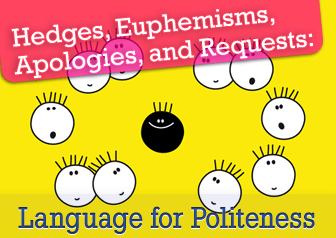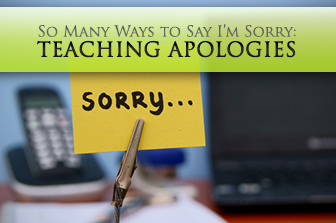Hedges, Euphemisms, Apologies, and Requests: Language for Politeness


So how do you teach your ESL students how to apologize in English? After all, not every culture has the same expectations when it comes to apologies. In U.S. culture, a good apology contains 6 parts.
Here is the anatomy of a good apology that you can present to your ESL students when they are learning to say I’m sorry.

Before apologizing, the offender needs to ask the offended for their attention. Depending on who the offended person is, the request may be casual, informal or formal. A person might start with a phrase like ‘excuse me, can we talk about something’, or ‘I wanted to talk to you about what happened yesterday’.
The next step in apologizing is to state what happened without making excuses. The speaker might say something like ‘I know I hurt your feelings’, ‘I caused a problem’, or ‘I forgot to do something’. The speaker should be honest and respectful of the other person.
The third piece of an apology is a sincere admission that you did something wrong. The apologizer can say something like ‘I messed up’, ‘I made a mistake’, or ‘I should not have done that’. The more specific the speaker can be, the better received the apology will be.
Step four is the actual apology. These words are what makes an apology an apology. The speaker should say ‘I’m sorry’ or ‘I apologize’. Speakers should be careful to say ‘I’m sorry I…’ rather than ‘I’m sorry you…’ or ‘I’m sorry if…’ The two latter phrases are likely to cause more offence or increase anger in the already offended.
Depending on how close the apologizer is to the offended person, he might choose to include humor to lighten the mood. This can help diffuse a tense atmosphere or melt the anger of the offended person. Particularly helpful is self deprecating humor, something that pokes fun at the person who offended.
Finally, the offended person should have time to forgive the offender. Depending on how serious the situation is, this may take seconds or days or even longer. Someone offering a good apology gives the other person time to resolve his or her feelings and seek reunification. It is key to avoid putting pressure on the offended party.
Role plays are great for this type of language practice. Start by brainstorming with your class different situations that would demand an apology like the ones below. These situations should range from the minor inconveniences, honest mistakes and serious offences.
Then brainstorm a list of phrases your students might use when making apologies in each of these situations. Once students have a plan and the vocabulary for their apology, have pairs of students choose a situation and role play an apology to one another. Make sure each student plays the role of the offender and the offended. If you like, have students come to the front of the class and perform their apologies for the class. This can be a fun activity for particularly dramatic students, and you can encourage entertainment and humor.
Minor Inconveniences
Honest Mistakes
Serious Offenses